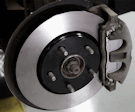Car dealerships I’ve wasted several hours now attempting to prove that I own my car — to Kia. And while this interaction is with the car company itself, it all goes back to the lack of follow through and knowledge of car dealerships. In today’s connected world, email addresses get associated with individual vehicles. So, …
Author's posts
Permanent link to this article: https://dashboardsymbols.com/2025/04/car-dealerships-frustrations/
Burnish the brakes?
Burnish We ran into something very curious while finishing our Tesla updates. It was a suggestion to burnish the brakes after replacing brake pads and/or brake rotors. They go on to say that this might eliminate high-pitched squealing noise while braking, particularly when driving in rain, cold and/or humid climates. We weren’t familiar with the …
Permanent link to this article: https://dashboardsymbols.com/2025/04/burnish-the-brakes/
Our Tesla symbols page is fully updated
Tesla symbols page After literally spending weeks updating Audi‘s dashboard symbols page, the update of the Tesla symbols page took less than a full day. We added but six symbols which required only three new versions. Other than an odd regeneration image, these were primarily color changes. The page now holds but 41 symbols and …
Permanent link to this article: https://dashboardsymbols.com/2025/04/our-tesla-symbols-page-is-fully-updated/
Tesla back-up start page is now up to date
Tesla back-up start Our Tesla back-up start page is now fully updated, adding changes to the all the original models and adding the Cybertruck for the first time. The Cybertruck relies solely on the smart phone app or a key card. The company does not even offer a key fob as an option. All models …
Permanent link to this article: https://dashboardsymbols.com/2025/04/tesla-back-up-start-page-is-now-up-to-date/
My only real complaint about the Kia Niro EV
Kia Niro EV If I have a single complaint regarding the Kia Niro EV I now drive, its the obnoxiously loud back-up warning the VESS (Virtual Engine Sound System) system gives off. And I’m not alone. The rules in the U.S. state that “The vehicle must make a continuous noise level of at least 56 …
Permanent link to this article: https://dashboardsymbols.com/2025/04/my-only-real-complaint-about-the-kia-niro-ev/
Tesla back-up open page updated
Tesla back-up open We have fully updated the Tesla back-up open page. It adds changes made to Model S and X open procedures as well as the first time addition of the Cybertruck. The Model 3 and Y procedures remain the same. In essence, all Tesla models now provide a touch point on the pilar …
Permanent link to this article: https://dashboardsymbols.com/2025/04/tesla-back-up-open-page-updated/
Audi symbols update is finished, at last
Audi symbols update And well, they did it. Our Audi symbols update is finally done and they did it. The page now features over 200 symbols and indicators — 210 to be exact. It goes without saying that they are new “leader” in sheer numbers. We added 81 symbols to the page, a full 67 …
Permanent link to this article: https://dashboardsymbols.com/2025/04/audi-symbols-update-is-finished-at-last/


Marc Favreau
The author has 30+ years of automotive experience and has assembled the most extensive collection of symbols and warning lights anywhere (over 1,000!) and can help you open and start any keyless start car with a dead key fob battery. BA, St. Joseph's, ME: MS, RPI, NY
Most commented posts